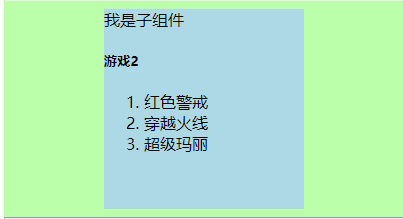
一文详解Vue插槽slot的使用与案例展示,看完就彻底明白了
目录
插槽 slot 在实际的项目开发中是经常使用的,主要分为三大类:默认插槽、具名插槽和作用域插槽,也是比较容易上手的。
一、插槽的含义
插槽 slot 是写在子组件的代码中,供父组件使用的占位符。在代码中,大致写为如下的形式,后面会进行详细的写法介绍。
<slot> </slot>
插槽其实就是在写 slot 的地方挖个坑,等着组件的使用者,即父组件,进行填充。子组件中使用插槽 slot 后,父组件可以在这个占位符中填充内容,包括数据、html代码、组件等,也就是说,当子组件的某部分内容是根父组件填充的不同而变化的,那我们就可以使用插槽slot,具体填充什么,由父组件而定。
让父组件向子组件指定位置插入html结构,也是一种组件间通信的方式,适用于父组件 => 子组件
话不多说,下面,我们就来看看 slot 的具体如何使用吧!
二、插槽的三种使用方法
1.默认插槽
有两个组件,App是父组件,Child是子组件
父组件代码如下:
<template>
<div class="parent">
<span>我是父组件</span>
<Child></Child>
</div>
</template>
<script>
import Child from './components/Child'
export default {
name:'app',
components:{
Child
}
}
</script>
<style scoped>
.parent{
width: 400px;
height: 400px;
background-color: #bfa;
}
</style>

子组件的代码:
<template>
<div class="child">
<div>我是子组件</div>
<br>
<slot>我是默认插槽,当父组件不填充任何内容时,我这句话才会出现</slot>
</div>
</template>
<script>
export default {
name:'Child',
data() {
return {
}
},
};
</script>
<style>
.child {
width: 200px;
height: 200px;
background-color: lightblue;
margin: auto;
}
</style>

启动项目,在浏览器中显示:

这时候,我们已经使用 slot ,在子组件中占了一个坑,但是我们还没有填充内容,接下来填充内容:

可以看到,填充的内容,确实在子组件中显示

假如,我们去掉子组件的插槽,父组件在子组件填充的内容还能看到吗?我们来试一试:
可以看到:浏览器中,只显示两个组件原本的信息,父组件填充的内容是看不到的。

在 slot 中,不仅可以填充文字,也可以填充图片、视频、HTML结构等,如填充图片:
 浏览器中显示如下:
浏览器中显示如下:

2.具名插槽
具名插槽,顾名思义,就是带有名字的插槽,具有 name 属性,一个不带 name 的
<slot>会带有默认的名字 default 。
在子组件中,slot 指定 name 属性
<template>
<div class="child">
<div>我是子组件</div>
<br>
<slot name="content">
我是插槽默认的内容,当父组件不填充任何内容时,我这句话才会出现
</slot>
</div>
</template>
<script>
export default {
name:'Child',
data() {
return {
}
},
};
</script>
<style>
.child {
width: 200px;
height: 200px;
background-color: lightblue;
margin: auto;
}
</style>
在父组件中,需要使用 template ,在 template 模板中,指定 slot 在子组件中的 name 值
<template>
<div class="parent">
<span>我是父组件</span>
<Child>
<template slot="content">
<div>这是父组件在子组件中填充的内容,在子组件中显示</div>
<br />
<img src="https://s3.ax1x.com/2021/01/16/srJlq0.jpg" alt="" />
</template>
</Child>
</div>
</template>
<script>
import Child from "./components/Child";
export default {
name: "app",
components: {
Child,
},
};
</script>
<style scoped>
.parent {
width: 400px;
height: 400px;
background-color: #bfa;
}
img {
width: 200px;
}
</style>
浏览器可以正常显示填充的内容:

假如,我们在父组件中,只写了 template ,并没有指定 slot 在子组件中的 name 值,

那么,浏览器中:

也就是说,在引用子组件的代码中, template 中的slot 是根据等号 = 后面的值,来寻找对应的插槽 slot ,从而在对应的位置上,填充相应的内容。当我们使用的插槽数量比较多时,具名插槽就有很大的实用性。
3.作用域插槽
如果数据在子组件,可以在子组件中直接使用数据,但根据数据生成的结构需要组件的使用者来决定,我们就需要用到作用域插槽,同时,我们也可以实现多种结构。
例如:games数据在子组件中,但使用数据所遍历出来的结构由父组件App决定
子组件中,使用 <slot :games="games"> 指明使用什么数据,并将数据传给插槽的使用者
<template>
<div class="child">
<span>我是子组件</span>
<h5>{{title}}</h5>
<slot :games="games">
我是插槽默认的内容,当父组件不填充任何内容时,我这句话才会出现
</slot>
</div>
</template>
<script>
export default {
name:'Child',
props:['title'],
data() {
return {
games:['红色警戒','穿越火线','超级玛丽'],
}
},
};
</script>
<style>
.child {
width: 200px;
height: 200px;
background-color: lightblue;
margin: auto;
}
</style>
在父组件中,使用子组件通过插槽传递过来的数据,渲染结构,有3种形式:
<template>
<div class="parent">
<span>我是父组件</span>
<Child title="游戏1">
<template scope="youxi1">
<!-- 无序列表结构 -->
<ul>
<li style="color:red" v-for="(g,index) in youxi1.games" :key="index">{{g}}</li>
</ul>
</template>
</Child>
<hr>
<Child title="游戏2">
<template slot-scope="youxi2">
<!-- 有序列表结构 -->
<ol>
<li v-for="(g,index) in youxi2.games" :key=index>{{g}}</li>
</ol>
</template>
</Child>
<hr>
<Child title="游戏3">
<template scope="{games}">
<!-- h4结构 -->
<h5 v-for="(g,index) in games" :key=index>{{g}}</h5>
</template>
</Child>
<hr>
</div>
</template>
<script>
import Child from "./components/Child";
export default {
name: "app",
components: {
Child,
},
};
</script>
<style scoped>
.parent {
width: 400px;
height: 700px;
background-color: #bfa;
}
img {
width: 200px;
}
</style>
浏览器中:

第1种:是基本用法,使用 scope = " youxi1 ",youxi1 是自定义的变量,来接收子组件传过来的数据,它是一个对象,使用插值语法,把 youxi1 打印出来:

第2种:将 scope 替换为 slot-scope
第3种:使用 es6 解构赋值的方法,直接将对象数据解构为数组,然后进行 v-for 的遍历
上述的小案例,就实现了:使用同样的数据,父组件将其渲染成不同的结构,非常方便实用。
4.版本变化
Vue 2.6.0 起,引入了 v-slot ,上文提到了3类插槽的 slot 和 slot-scope ,可以直接替换为 v-slot ,在vue2版本中,我们仍可以使用 slot 和 slot-scope ,但是在vue3中就只能使用v-slot了。详细内容参见 vue官方文档 的解释。
更多推荐
 已为社区贡献4条内容
已为社区贡献4条内容







所有评论(0)